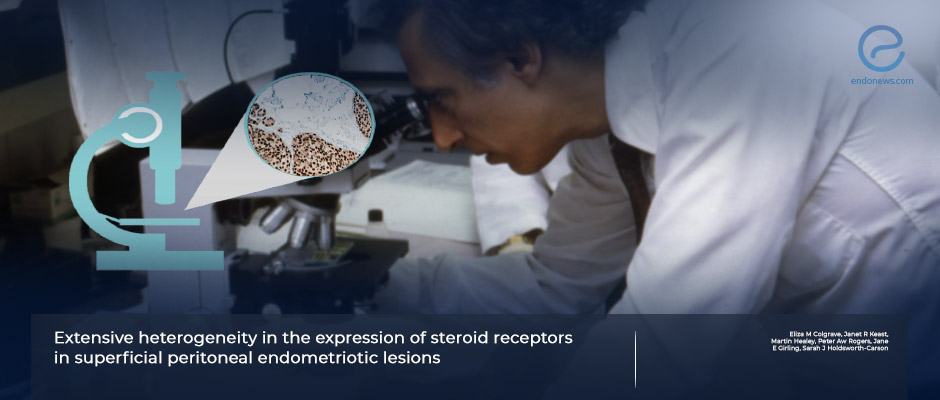Analysis of steroid hormone receptors in endometriotic tissues reveals chaotic results
Jan 12, 2024
A sophisticated research on sterid receptors in endometriotic tissues
Key Points
Highlights:
- Hormonal therapies, such as oral contraceptives, progestins, levonorgestrel-releasing intrauterine devices etc. are frequently used to treat endometriosis patients. Investigating the nature of steroid hormone receptors in endometriotic tissues utilizing antibodies, i.e. immunohistology, have shown variable and somewhat contradictory results.
Importance:
- Delineation of steroid hormone receptors in endometriotic lesions besides correlating with other markers of proliferation - apoptosis and gland profile morphology may yield scientific clues into the mechanisms of endometriosis proliferation, regression, or both.
What’s done here:
- This study has examined immunostaining patterns of representative steroid hormone receptors (ERa and progesterone receptorA/B) and markers of lesion activity such as cell proliferation marker (Ki67), and apoptosis-resistance (Bcl-2) in peritoneal endometriotic lesions, and their relationship with menstrual cycle stage, lesion location and gland profile morphology.
Key results:
- Expressions of estrogen receptor-a and progesterone receptorA/B in peritoneal endometriosis tissues are prominently heterogeneous.
- Bcl-2 immunostainings in endometriosis lesions are also not similar, however the proliferative index (Ki-67) is low.
- Menstrual cycle stage correlations were limited in steroid hormone receptor and Bcl-2 visulizations in lesions.
- Steroid hormone receptors and Bcl-2 between lesions, even within an individual patient have shown great variations.
Potential limitations:
- The endometriotic tissues examined within a single biopsy could have originated from a single continuous lesion or different multiple foci, further emphasizing the importance of defining features within intact or digitally reconstructed structures.
Lay Summary
A group of researchers from academic institutions located at Australia and New Zeland, led by Dr. Holdsworth-Carson, have published their recent findings on steroid receptors in peritoneal endometriosis lesions by immunohistochemistry, in the journal Reproduvtive Biomedicine Online.
Endometriosis is notoriously disabling disease affecting millions of women worldwide, and both medical and surgical tmanagement are far from perfect, leading the welfare of the patients to jeopardy.
Oral contraceptives, progestins, levonorgestrel-releasing intrauterine devices and several other hormonal theraupetics are frequently used in this regard. However, research on steroid hormone receptors in endometriotic tissues utilizing antibodies, i.e. immunohistochemistry, yiielded quite variable and somewhat contradictory results. Clarification of steroid hormone receptors in endometriotic lesions besides correlating markers of proliferation/apoptosis and gland profile morphology may yield valuable data related to mechanisms of endometriosis proliferation, regression, or both.
The authors examined immunostaining patterns of representative steroid hormone receptors (ERa and progesterone receptorA/B) and markers of lesion activity (cell proliferation:Ki67, and apoptosis-resistanceBcl-2) in superficial peritoneal endometriotic lesions, besides correlating with menstrual cycle stage, lesion location and gland profile morphology.
Twenty-four patients with surgically and histopathologically confirmed endometriosis were included in the study. Immunfluorescence microscopy was used to determine the proportion of Estrogen Receptor-a(ERa), Progesterone receptor A/B, Bcl2 and Ki67 in 271 lesions of 67 tissue biopsies representing endometriosis, following utilisation of appropriate antibodies. Data was analysed to examine the relationship with menstrual date, lesion location and gland architecture. Expressions of Estrogen Receptor-a and Progesterone ReceptorA/B in superficial peritoneal endometriosis were heterogeneous. Bcl-2 immunostainings in endometriosis lesions are also not the same, however the proliferative index (Ki-67) was low. Menstrual cycle stage correlations were limited in steroid hormone receptor and Bcl-2 visulizations in lesions. Steroid hormone receptors and Bcl-2 between lesions, even within an individual patient have shown great variations.
There seems to be a potential limitation related to endometriotic tissues examined within a single biopsy whether this originated from a single continuous lesion or different multiple foci, further emphasizing the importance of defining features within intact or digitally reconstructed structures.
Research Source: https://pubmed.ncbi.nlm.nih.gov/38134474/
endometriotic lesion steroid receptor proliferation index ap

